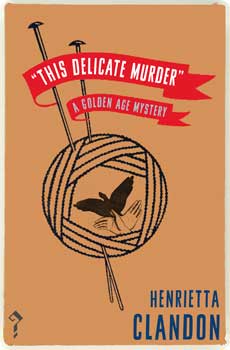A review of This Delicate Murder by Henrietta Clandon – 240212
The prolific Anglo-Irish writer John Vahey published books under a number of pseudonyms including Henrietta Clandon. This Delicate Murder, originally published in 1936 and reissued by Dean Street Press, uses a lesser used trope from Golden Age detective fiction, a shooting party, this one held at Chustable Manor. In what is a form of impossible murder, Clandon is able to assemble a motley collection of characters, their two common traits being that they inhabit the literary world and all loathe to greater or lesser extent their host, Lionel Fonders. It is the first of three Clandon novels that are narrated by Henrietta Penelope (Penny) Mercer.
All those invited to blast pheasants and pigeons to kingdom come are duffers with a gun, with the exception of Keble Musson, who, unlike the others, is a literary agent rather than a writer and is negotiating to acquire the North American rights to Fonders’ future works. One of the party, Adie Stole, who writes desert romances, is a pretty erratic shooter and quickly earns the enmity of the dour Scottish gamekeeper, McPherson.
Fonders, who had lost his left eye in the Great War, is found dead in his hide, having been shot through the eye hole with unerring precision. The distance of the other hides to that of Fonders’ is greater than the range of the rifles being used, but in terms of proximity and the fact he admits having a tracer bullet in his possession, the finger of suspicion points to Penny’s husband, Vincent (Vincie). To protect his position, Vincie employs a clever lawyer and amateur sleuth, William Power, to help unearth what really went on at Theby Wood, who killed Fonders and why.
Much of the investigation involves investigations into ballistics, the bores of guns, their range and the characteristics of shot and tracer bullets. There is a danger that the story could descend into Wills Crofts and Thorndyke territory and while, of necessity, there is much of a quasi-technical nature, Clandon does handle it with relatively light hand and leaves the reader with just enough information to understand the point being made.
The other significant problem is that it is quite difficult to keep track of who was in which hide when and the topographical features of the area and, in particular, the sight lines. There is a map at the beginning of the book and I took a screenshot of it – I was reading the Kindle edition – to help me. Much depends on the precise positioning of each member of the shooting party.
To his dismay, Vincie has been appointed one of the executors to Fonders’ estate, a responsibility from which he is keen to relieve himself, but it provides a key to the mystery. An old manuscript is found amongst Fonders’ papers which was sent unsolicited to him by a handicapped person in America. It is dreadful but the plot has an uncanny resemblance to his best seller published a year later. The case turns out to be one of literary plagiarism and revenge.
The denouement is clever, although, to my mind, there was really only one likely culprit and Power is able to demonstrate his brilliance by delivering a perfect solution to the police. The strength of the book lies in its wit and humour, a lovely portrayal of the literary world with all its bitchiness and thwarted ambitions. It is a comedy of manners and while some of the in jokes might pass a reader at this distance by, it is easy to get the gist. I did not enjoy it as much as the other Clandon novels I have read, but it is fun and entertaining.
